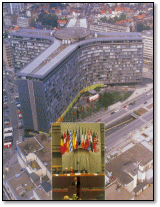1940/1960
The years of conflict and reconstruction
 1940/45. World War II ended, leaving a ruined and devastated Europe - but
with new energies and advanced technologies to draw on.
1940/45. World War II ended, leaving a ruined and devastated Europe - but
with new energies and advanced technologies to draw on.
1945/1960. The needs were enormous. Homes and factories had to be rebuilt and
essential capital and consumer goods produced. Europe experienced a euphoric
period of full employment as companies experienced constant growth.
Some key dates
|
1941
|
-
|
Turbojet aircraft
|
|
|
-
|
Penicillin (discovered in 1928)
|
|
|
|
1942
|
-
|
Atomic battery
|
|
|
-
|
Plutonium
|
|
|
|
1944
|
-
|
V1 and V2 flying bombs
|
|
|
-
|
A customs agreement, signed in London between Belgium, the Netherlands and
Luxembourg, marks the birth of the BENELUX.
|
|
|
-
|
Hi-Fi equipment
|
|
|
|
1945
|
-
|
Atom bomb
|
|
|
-
|
Yalta Conference
|
|
|
|
1946
|
-
|
Electronic calculator
|
|
|
|
1947
|
-
|
Industrial cybernetics
|
|
|
-
|
Supersonic aircraft
|
|
|
|
1948
|
-
|
French atomic battery
|
|
|
-
|
Transistor
|
|
|
-
|
BENELUX - Customs Union
|
|
|
|
1949
|
-
|
Atlantic Pact Agreement
|
|
|
|
1950
|
-
|
Common market for coal, iron and steel
|
|
|
|
1951
|
-
|
Creation of the ECSC (European Coal and Steel Community)
|
|
|
|
1954
|
-
|
Nuclear submarine
|
|
|
|
1955
|
-
|
Maiden flight of the Caravelle
|
|
|
|
1956
|
-
|
First nuclear plant
|
|
|
-
|
Annual paid holidays increased to 3 weeks.
|
|
|
|
1957
|
-
|
Sputnik I launched into orbit
|
|
|
-
|
First living creature launched into space (artificial satellite -
Laïka dog)
|
|
|
-
|
The Common Market is founded (Treaty of Rome).
|
|
|
|
1958
|
-
|
Foundation of Nasa
|
|
|
-
|
First US satellite - Explorer 1
|
|
|
-
|
BENELUX - European Union.
|
|
Europe takes shape
1948. Confirmation : "CEBEC", the compulsory quality mark.
Approved by the official bodies, all electrotechnical equipment now had to bear
the CEBEC quality mark. Since this time, the CEBEC mark of
has been the user's guarantee of a product which has passed all the tests and
controls to ensure compliance with Belgian standards, the lasting quality of
its components and materials, and the rigour of the production process and
system.
1949 - Foundation of the Council of Europe
The first step on the road to the European Union, on the initiative of Robert
Schuman and with the support of Paul-Henri Spaak and Jean Rey.
1951 - Foundation of the ESCA
Belgium is represented by Paul Van Zeeland.
1957 - Treaty of Rome
Creation of the common market, with the aim of achieving a rapid improvement in
living standards through the free movement of goods, persons and capital and
the introduction of common policies in the fields of agriculture, competition,
energy and transport.
1958 - Common Market Commission.
With its headquarters in Brussels, the Commission's first president is Jean Rey.
The practical construction of Europe is by means of directives. The most
important for electrotechnical materials are the following :
-
the 1973 "low tension" directive
-
the 1988 "toys" directive
-
the 1989 "electromagnetic compatibility" directive
-
the 1989 "machines" directive
-
the 1990 "active medical implants" directive
-
the 1991 "telecommunication terminals" directive
-
the 1993 "medical devices" directive
Generalisation of "EC" marking from 1993.
In order to ensure compliance with these directives, the European authorities
employed the services of approved bodies, including CEBEC.
... Some famous names...
JANET Paul (1863-1937).
Physicist. Director of the Central Laboratory of the Ecole Supérieure
d'Electricité de Paris. Appointed to the Belgian Society of Electricians
in 1934.
DULAIT Julien (1855-1926).
Civil mining engineer. Co-founder and managing director of the
Société d'Electricité et Hydraulique. Inventor of the
dynamo, a dynamo-meter and a regulator. One of the founders of the ACEC, of
which he was managing director. In 1883 he organised the first course in
electricity at the Charleroi school of industry.
BAEKELAND Leo-Hendrik (1863-1944).
Chemist. Professor at New York's Columbia University. Inventor of Bakelite, now
used worldwide.
DE BAST Omer (1865-1937).
Head of the Montefiore Institute of Electrotechnics. Research on multiphase
asynchronous motor.
de GERLACHE Adrien (1866-1934).
Engineer. Naval officer. Between 1897 and 1899 led "Belgica" sailing boat
expeditions to the Antarctic regions and in 1898 discovered the straits to
which he lent his name.
|
|


